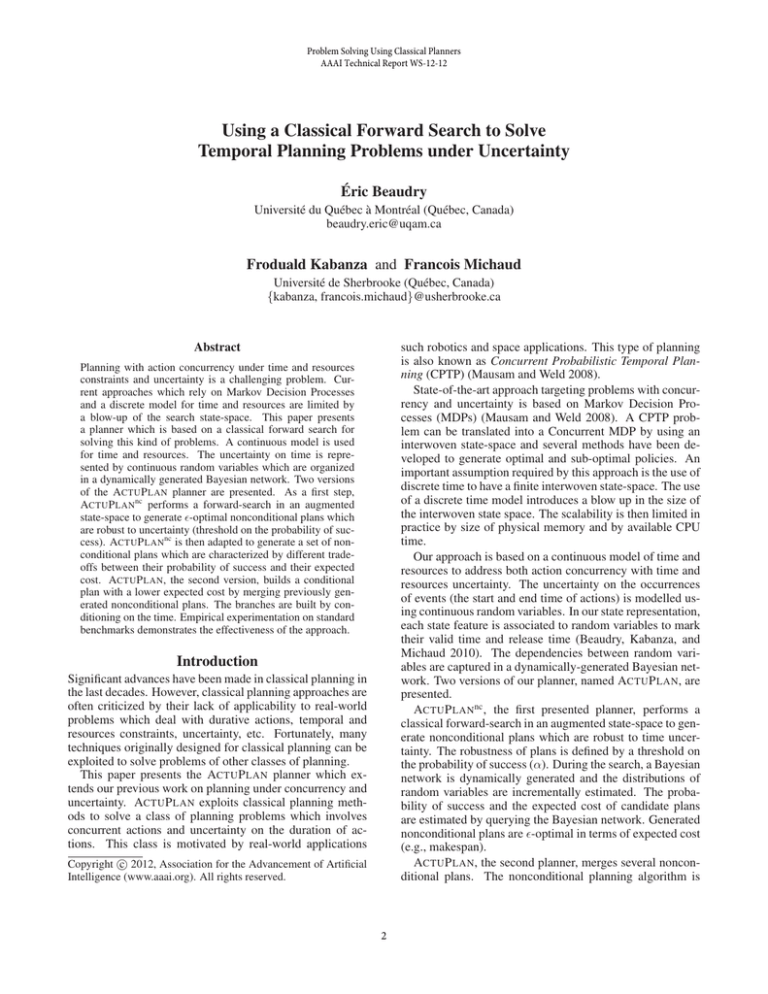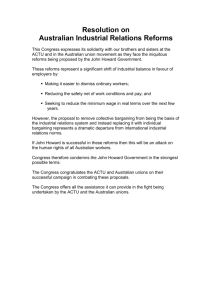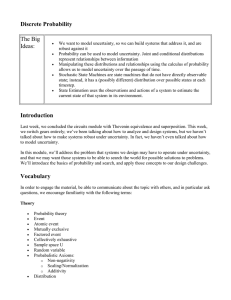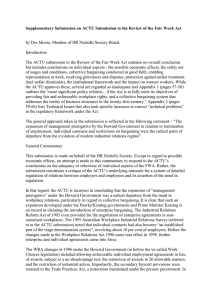
Problem Solving Using Classical Planners
AAAI Technical Report WS-12-12
Using a Classical Forward Search to Solve
Temporal Planning Problems under Uncertainty
Éric Beaudry
Université du Québec à Montréal (Québec, Canada)
beaudry.eric@uqam.ca
Froduald Kabanza and Francois Michaud
Université de Sherbrooke (Québec, Canada)
{kabanza, francois.michaud}@usherbrooke.ca
Abstract
such robotics and space applications. This type of planning
is also known as Concurrent Probabilistic Temporal Planning (CPTP) (Mausam and Weld 2008).
State-of-the-art approach targeting problems with concurrency and uncertainty is based on Markov Decision Processes (MDPs) (Mausam and Weld 2008). A CPTP problem can be translated into a Concurrent MDP by using an
interwoven state-space and several methods have been developed to generate optimal and sub-optimal policies. An
important assumption required by this approach is the use of
discrete time to have a finite interwoven state-space. The use
of a discrete time model introduces a blow up in the size of
the interwoven state space. The scalability is then limited in
practice by size of physical memory and by available CPU
time.
Our approach is based on a continuous model of time and
resources to address both action concurrency with time and
resources uncertainty. The uncertainty on the occurrences
of events (the start and end time of actions) is modelled using continuous random variables. In our state representation,
each state feature is associated to random variables to mark
their valid time and release time (Beaudry, Kabanza, and
Michaud 2010). The dependencies between random variables are captured in a dynamically-generated Bayesian network. Two versions of our planner, named ACTU P LAN, are
presented.
ACTU P LANnc , the first presented planner, performs a
classical forward-search in an augmented state-space to generate nonconditional plans which are robust to time uncertainty. The robustness of plans is defined by a threshold on
the probability of success (α). During the search, a Bayesian
network is dynamically generated and the distributions of
random variables are incrementally estimated. The probability of success and the expected cost of candidate plans
are estimated by querying the Bayesian network. Generated
nonconditional plans are -optimal in terms of expected cost
(e.g., makespan).
ACTU P LAN, the second planner, merges several nonconditional plans. The nonconditional planning algorithm is
Planning with action concurrency under time and resources
constraints and uncertainty is a challenging problem. Current approaches which rely on Markov Decision Processes
and a discrete model for time and resources are limited by
a blow-up of the search state-space. This paper presents
a planner which is based on a classical forward search for
solving this kind of problems. A continuous model is used
for time and resources. The uncertainty on time is represented by continuous random variables which are organized
in a dynamically generated Bayesian network. Two versions
of the ACTU P LAN planner are presented. As a first step,
ACTU P LANnc performs a forward-search in an augmented
state-space to generate -optimal nonconditional plans which
are robust to uncertainty (threshold on the probability of success). ACTU P LANnc is then adapted to generate a set of nonconditional plans which are characterized by different tradeoffs between their probability of success and their expected
cost. ACTU P LAN, the second version, builds a conditional
plan with a lower expected cost by merging previously generated nonconditional plans. The branches are built by conditioning on the time. Empirical experimentation on standard
benchmarks demonstrates the effectiveness of the approach.
Introduction
Significant advances have been made in classical planning in
the last decades. However, classical planning approaches are
often criticized by their lack of applicability to real-world
problems which deal with durative actions, temporal and
resources constraints, uncertainty, etc. Fortunately, many
techniques originally designed for classical planning can be
exploited to solve problems of other classes of planning.
This paper presents the ACTU P LAN planner which extends our previous work on planning under concurrency and
uncertainty. ACTU P LAN exploits classical planning methods to solve a class of planning problems which involves
concurrent actions and uncertainty on the duration of actions. This class is motivated by real-world applications
c 2012, Association for the Advancement of Artificial
Copyright Intelligence (www.aaai.org). All rights reserved.
2
• U is a total mapping function U : X → ∪x∈X Dom(x)
which retrieves the current assigned value for each variable x ∈ X such that U(x) ∈ Dom(x).
adapted to generate several nonconditional plans which are
characterized by different trade-offs between their probability of success and their expected cost. The resulting conditional plan has a lower cost and/or a higher probability of
success than individual nonconditional plans. The switch
conditions within the plan are built through an analysis of
the estimated distribution probability of random variables.
• V is a total mapping function V : X → T which denotes
the valid time at which the assignation of variables X have
become effective.
• R is a total mapping function R : X → T which indicates the release time on state variables X which correspond to the latest time that over all conditions expire.
Basic Concepts
This section introduces basic concepts behind ACTU P LAN.
These concepts are illustrated with examples on the Transport domain (from the International Planning Competition)
on which uncertainty has been added to the duration of actions. In that planning domain a set of trucks have to drive
and deliver packages distributed over a given map. A package is either at a location or loaded onto a truck. There is no
limit on the number of packages a truck can transport at the
same time and on the number of trucks that can be parked at
same location.
The release times of state variables are used to track
over all conditions of actions. The time random variable
t = R(x) means that a change of the state variable x cannot be initiated before time t. The valid time of an state
variable is always before or equals to its release time, i.e.,
V(x) ≤ R(x)∀x ∈ X. The valid time (V) and the release
time (R) respectively correspond to the write-time and the
read-time in Multiple-Timeline of SHOP2 planner (Do and
Kambhampati 2003), with the key difference here being that
random variables are used instead of numerical values.
Hence, a state is not associated with a fixed timestamp
as in a classical approach for action concurrency (Bacchus
and Ady 2001). Only temporal uncertainty is considered in
this paper, i.e., there is no uncertainty about the values being assigned to state variables. Dealing with this kind of
uncertainty is planned as future work. The only uncertainty
on state variables is about when their assigned values become valid. The valid time V(x) models this uncertainty by
mapping each state variable to a corresponding time random
variable.
Figure 1 illustrates an example of a state in the Transport
domain. The left side (a) is illustrated using a graphical representation on a map. The right side (b) presents state s0 in
ACTU P LAN formalism. Two trucks r1 and r2 are respectively located at locations l1 and l4 . Package b1 is loaded on
r1 and package b2 is located at location l3 . The valid time of
all state variables is set to time t0 .
State Variables
State features are represented as state variables which is
equivalent to a classical representation (Nebel 2000). A state
variable x ∈ X describes a particular feature of the world
state associated to a finite domain Dom(x). A world state is
an assignment of values to the state variables, while action
effects (state updates) are changes of variable values. This
paper only focus on temporal uncertainty. It is assumed that
no exogenous events take place; hence only planned actions
cause state changes.
For instance, the Transport domain involves the following objects: a set of trucks R = {r1 , . . . , rn }, a set of
packages B = {b1 , . . . , bm } and a set of locations L =
{l1 , . . . , lk } distributed over a map. The set of state variables X = {Cr , Cb | r ∈ R, b ∈ B} specifies the current location of trucks and packages. The domain of variables is
defined as Dom(Cr ) = L (∀r ∈ R) and Dom(Cb ) = L ∪ R
(∀b ∈ B).
Time Random Variables
The uncertainty related to time is represented using continuous random variables. A time random variable t ∈ T marks
the occurrence of an event, corresponding to either the start
or the end of an action. An event induces a change of the values of a subset of state variables. The time random variable
t0 ∈ T is reserved for the initial time, i.e., the time associated to all state variables in the initial world state. Each
action a has a duration represented by a random variable
da . A time random variable t ∈ T is defined by an equation
specifying the time at which the associated event occurs. For
instance, an action a starting at time t0 will end at time t1 ,
the latter being defined by the equation t1 = t0 + da .
(a) Graphical representation
(b) State representation
Figure 1: Example of a state for the Transport domain
Actions
The specification of actions follows the extensions introduced in PDDL 2.1 level 3 (Fox and Long 2003) for expressing temporal planning domains. The set of all actions
is denoted by A. An action a ∈ A is a tuple a=(params,
cstart, coverall, estart, eend, da ) where :
States
A state describes the current world state using a set of state
features, that is, a set of value assignations for all state variables. A state s is defined by s = (U, V, R) where:
3
• params is a list of parameters p1 , . . . , pn , each one taking
a value in the domain of a state variable;
• cstart is the set of at start conditions that must be satisfied at the beginning of the action;
• coverall is the set of persistence conditions that must be
satisfied over all the duration of the action;
• estart and eend are respectively the sets of at start and
at end effects on the state variables;
• and da ∈ D is the random variable which models the
duration of the action.
A condition is a pair c = (p, x) which is interpreted as
a Boolean expression p = s.U(x) where s is an implicit
state. The function vars(c) → 2X returns the set of all state
variables that are referenced by the condition c.
An effect e = (x, exp) specifies the assignation of the
value resulting from the evaluation of expression exp to the
state variable x. The expressions conds(a) and effects(a)
return, respectively, all conditions and all effects of action a.
The set of action duration random variables is defined by
D = {da | a ∈ A} where A is the set of actions. A random
variable da for an action follows a probability distribution
specified by a probability density function φda : R+ → R+
and a cumulative distribution function Φda : R+ → [0, 1].
An action a is applicable in a state s if and only if state s
satisfies all at start and over all conditions of a. A condition
c ∈ conds(a) is satisfied in state s if c is satisfied by the
current assigned values of state variables of s.
Algorithm 1 A PPLY action function
1. function A PPLY (s, a)
2.
s0 ← s
3.
tconds ← maxx∈vars(conds(a)) s.V(x)
4.
trelease ← maxx∈vars(effects(a)) s.R(x)
5.
tstart ← max(tconds , trelease )
6.
tend ← tstart + da
7.
for each c ∈ a.coverall
8.
for each x ∈ vars(c)
9.
s0 .R(x) ← max(s0 .R(x), tend )
10.
for each e ∈ a.estart
11.
s0 .U(e.x) ← eval(e.exp)
12.
s0 .V(e.x) ← tstart
13.
s0 .R(e.x) ← tstart
14.
for each e ∈ a.eend
15.
s0 .U(e.x) ← eval(e.exp)
16.
s0 .V(e.x) ← tend
17.
s0 .R(e.x) ← tend
18.
returns s0
Figure 2 illustrates two state transitions. Figure 3 presents
the corresponding Bayesian network. Colours are used to
differentiate types of random variables. State s1 is obtained by applying the action Goto(r1 , l1 , l2 ) from state
s0 . The A PPLY function (see Algorithm 1) works as follows. The action Goto(r1 , l1 , l2 ) has the at start condition
Cr1 = l1 . Because Cr1 is associated to t0 , we have tconds =
max(t0 ) = t0 . Since the action modifies the Cr1 state variable, Line 4 computes the time trelease = max(t0 ) = t0 .
At Line 5, the action’s start time is defined as tstart =
max(tconds , trelease ) = t0 , which already exists. Then, at
Line 6, the time random variable tend = t0 + dGoto(r1 ,l1 ,l2 )
is created and added to the Bayesian network with the label
t1 . Next, Lines 13–16 apply effects by performing the assignation Cr1 = l2 and by setting time t1 as the valid time for
Cr1 . State s2 is obtained similarly.
ACTU P LANnc : Nonconditional Planner
The ACTU P LANnc algorithm expands a search graph in the
state space and dynamically generates a Bayesian network
which contains random variables.
State Transition
Algorithm 1 describes the A PPLY function which computes
the state resulting from application of an action a to a state
s. Time random variables are added to the Bayesian network when new states are generated. The start time of an
action is defined as the earliest time at which its requirements are satisfied in the current state. Line 3 calculates the
time tconds which is the earliest time at which all at start
and over all conditions are satisfied. This time corresponds
to the maximum of all time random variables associated to
the state variables referenced in the action’s conditions. Line
4 calculates time trelease which is the earliest time at which
all persistence conditions are released on all state variables
modified by an effect. Then at Line 5, the time random variable tstart is generated. Its defining equation is the max
of all time random variables collected in Lines 3–4. Line 6
generates the time random variable tend with the equation
tend = tstart + da . Once generated, the time random variables tstart and tend are added to the Bayesian network if
they do not already exist. Lines 7–9 set the release time to
tend for each state variable involved in an over all condition.
Lines 10–17 process at start and at end effects. For each effect on a state variable, they assign this state variable a new
value, set the valid and release times to tstart and add tend .
Figure 2: Example of two state transitions in the Transport
domain
Algorithm 2 presents the planning algorithm of
ACTU P LANnc in a recursive form. This planning algorithm performs best-first-search in the state space defined
in previous section to find a state which satisfies the goal
with a probability of success greater than or equal a given
threshold α (Line 2). The α parameter is a hard constraint
of the probability of success of output plans and must be
4
(a) State-space
(b) Bayesian network
Figure 4: Sample search with the Transport domain
Algorithm 2 Nonconditional planning algorithm
1. ACTU P LANnc (s, G, A, α)
2.
if P (s |= G) ≥ α
3.
π ← ExtractNonConditionalPlan(s)
4.
return π
5.
nondeterministically choose a ∈ A
6.
s0 ← A PPLY(s, a)
7.
if P (s0 |=∗ G) ≥ α
8.
return ACTU P LANnc (s0 , G, A, α)
9.
else return FAILURE
Figure 3: Example of a Bayesian network
Example on Transport domain
interpreted as a tolerance to failures. If s |= G then a
nonconditional plan π is built (Line 3) and returned (Line
4). The choice of an action a at Line 5 is a backtrack
point. A heuristic function based on the hmax (Haslum and
Geffner 2000) is involved to guide this choice. It estimates
a lower bound on the expected value of the minimum
makespan reachable from a state s. The optimization
criteria is implicitly given by a given metric function cost.
Line 6 applies the chosen action to the current state. At Line
7, an upper bound on the probability that state s can lead to
a state which satisfies goal G is evaluated. The symbol |=∗
is used to denote a goal may be reachable from a given state,
i.e. their may exist a plan. The symbol P denotes an upper
bound on the probability of success. If that probability is
under the fixed threshold α, the state s is pruned. Line 8
performs a recursive call.
Figure 4 illustrates an example of a partial search carried
out by Algorithm 2 on a problem instance of the Transport
domain. The goal in that example is defined by G = {Cb1 =
l4 }. Note that trucks can only travel on paths of its color.
For instance, truck r1 cannot move from l2 to l4 . A subset
of expanded states is shown in (a). The states s0 , s1 and s2
are the same as previous figures except that
State s3 is obtained by applying Unload (r1 , l2 , b1 ) action
from state s2 . This action has two conditions : the at start
condition Cb1 = r1 and the over all condition Cr1 = l2 .
The action has the at end Cb1 = l2 effect. The start time
of this action is obtained by computing the maximum time
of all valid times of state variables concerned by conditions
and all release times of state variables concerned by effects.
The start time is then max(t0 , t1 ) = t1 . The end time is
t3 = t1 + dUnload(r1 ,l2 ,b1 ) . Because the over all condition
5
Cr1 = l2 exits, the release time R(Cr1 ) is updated to t3 .
This means that another action cannot move truck r1 away
from l2 before t3 .
State s4 is obtained by applying Load (r2 , l2 , b1 ) action
from state s3 . This action has two conditions : the at start
condition Cb1 = l2 and the over all condition Cr2 = l2 . The
action has the at end Cb1 = r2 effect. The start time is then
t4 = max(t2 , t3 ). The end time is t5 = t4 + dLoad(r2 ,l2 ,b1 ) .
The goal G is finally satisfied in state s6 . A nonconditional
temporal plan is extracted from this state.
in Figure 5, with the respect of nonconditional plans πa
and πb , there is two possible actions : Goto(r1 , l4 , l8 ) or
Goto(r1 , l4 , l9 ).
Building Conditional Plans
The conditional planner (ACTU P LAN) proceeds in two
steps. It first expands a state space using Algorithm 3. This
algorithm is a modified best-first-search that generates the
set of all reachable states F which satisfy the goal with a cost
(e.g. makespan) of at most tα . The tα is obtained by generating a nonconditional plan using α parameter. At Line 17,
we store in f attribute the final cost (e.g. makespan) to reach
state s0 which satisfies the goal with a probability ≥ β. The
β parameter controls the quality of the solution. Intuitively,
when β is equals to α, only a nonconditional plan could be
extracted. Lower β is then more states are generated and better could be the generated conditional plans. When β tends
to zero, the generated conditional plans will be approximate
solutions of an optimal policy.
ACTU P LAN : Conditional Plannner
The conditional planner is built on top of the nonconditional
planner presented in previous section. The basic idea behind the conditional planner is that the nonconditional planner can be modified to generate several nonconditional plans
with different trade-offs on their probability of success and
their cost. A better conditional plan is then obtained by
merging multiple nonconditional plans. Time conditions are
set to control execution.
Consider the following situation. A truck initially parked
in location l2 has to deliver two packages b0 and b1 from
locations l9 and l8 to locations l6 and l8 . Please refer to
the map on the left of Figure 5. The package b0 destined to
location l6 has time t = 1800 as a delivery deadline. The
cost is defined by the total duration of the plan (makespan).
There exists at least the two following possible nonconditional plans πa and πb . The plan πa delivers package b0
first while plan πb delivers package b1 first. Since package
b0 has the earliest deadline, plan πa has an higher probability of success than plan πb . However, plan πa has a longer
makespan than plan πb because its does not take the shortest
path. If the threshold on the probability of success if fixed
to α = 0.8, the nonconditional plan πa must be returned by
ACTU P LANnc .
Algorithm 3 Algorithm for generating a set of nonconditional plans
1. E XPAND G RAPH (s0 , G, A, α, β)
2.
open ← {s0 }
3.
close ← ∅
4.
tα ←∼ N (+∞, 0)
5.
while open =
6 ∅
6.
s ← open.RemoveFirst()
7.
add s to close
8.
if maxx∈X (s.V(x)) > tα exit while loop
9.
if P (s |= G) ≥ β
10.
add s to F
11.
if P (s |= G) ≥ α
12.
tα ← min(tα , maxx∈X (s.V(x)))
13.
else
14.
for each a ∈ A such a is applicable in s
15.
s0 ← Apply(s, a)
16.
add s0 to s.parents
17.
s0 .f ← EvaluateHeuristic(s0 , G, β)
18.
if s0 ∈
/ close and P (s0 |=∗ G) ≥ β
19.
add s0 to open
20.
return F
Once the graph has been generated by Algorithm 3, the
second step is to recursively generate branching conditions
from states in set F to the initial state. Conditions are computed by estimating critical times (λmin and λmax ) for each
actions. The critical time λa,max is obtained by estimating
the latest time at which starting action a leads to a probability of success of at least α. The critical time λa,min is
obtained by estimating the earliest time at which it better to
start action a than waiting for starting another action. Figure 6 illustrates an example how critical times are computed
for state s2 from Figure 5 for the threshold α = 0.8. Small
solid lines show the estimated probability of success of actions a and b when they are started at a decision time λ. We
see that the probability of success of starting action a at time
λ drops under 0.8 at λa,max = 642. This means that action
a should not be selected later than time 642. The large solid
Figure 5: Possible actions in state s2
A better solution is to delay the decision about which
package to deliver first. The common prefix of plans πa
and πb (Goto(r1 , l2 , l4 ), Load(r1 , l4 , b1 )) is first executed.
Let the resulting state of this prefix be s2 . As illustrated
6
lines is indicates the expected probability when actions are
started before λ. Critical times λmin are obtained similarly.
times of actions, as well as their duration. Since a continuous model is more compact than discrete representations,
it helps avoid the state space explosion problem. Two planning algorithms have been presented. The nonconditional algorithm (ACTU P LANnc ) produces -optimal nonconditional
plans by performing a classical forward-search in the state
space. A conditional planning algorithm (ACTU P LAN) generates conditional plans which are an approximation of optimal plans. The conditional plans are obtained by merging
several nonconditional plans having different trade-offs between their quality and probability of success. Empirical
results showed the efficiency of our approach on planning
domains having uncertainty on the duration of actions.
Acknowledgements
This work was funded by the Natural Sciences and Engineering Research Council of Canada.
References
Bacchus, F., and Ady, M. 2001. Planning with resources
and concurrency: A forward chaining approach. In Proc. of
the International Joint Conference on Artificial Intelligence,
417–424.
Beaudry, É.; Kabanza, F.; and Michaud, F. 2010. Planning for concurrent action executions under action duration
uncertainty using dynamically generated bayesian networks.
In Proc. of the International Conference on Automated Planning and Scheduling, 10–17.
Do, M., and Kambhampati, S. 2003. SAPA: A scalable
multi-objective metric temporal planner. Journal of Artificial Intelligence Research 20:155–194.
Fox, M., and Long, D. 2003. PDDL 2.1: An extension to
PDDL for expressing temporal planning domains. Journal
of Artificial Intelligence Research 20:61–124.
Haslum, P., and Geffner, H. 2000. Admissible heuristics
for optimal planning. In Proc. of the Artificial Intelligence
Planning Systems, 140–149.
Mausam, and Weld, D. S. 2008. Concurrent probabilistic temporal planning. Journal of Artificial Intelligence Research 31:33–82.
Nebel, B. 2000. On the compilability and expressive power
of propositional planning formalisms. Journal of Artificial
Intelligence Research 12:271–315.
Figure 6: Latest times for starting actions
Empirical Results
We compared our planners to an MDP based planner (Mausam and Weld 2008) on the Transport domain. Table 1 presents empirical results. The nonconditional planner (ACTU P LANnc ) was run with α = 0.9. The conditional
planner (ACTU P LAN) was run with α = 0.9 and β = 0.4.
The first two columns show the size of the problems (number of trucks and packages). Columns under each planner report the CPU time, the probability of success and the
cost (makespan). Results show that the conditional planner
reduced the expected makespan for most of the problems,
when it is possible. For few problems, there does not exist
conditional plan which is strictly better than the nonconditional one.
Generated conditional plans are generally better plans but
require much more CPU time than ACTU P LANnc . This time
is required because an optimal conditional plan may require
the combination of many plans, which requires to explore a
much larger part of the state space. In practice, the choice
between ACTU P LANnc and ACTU P LAN should be guided
by the potential benefit of having smaller costs. There is a
trade-off between plans quality and required time to generate
them. When a small improvement on the cost of plans has
a significant consequence, then ACTU P LAN should be used.
If decisions have to be taken rapidly, then ACTU P LANnc is
more appropriate.
Conclusion
This paper presented ACTU P LAN, which is based a new
approach for planning under time constraints and uncertainty. The first contributions are a new state representation
which is based on a continuous model of time. Continuous random variables are used to model the uncertainty on
the time. Time random variables define the start and end
7
Table 1: Empirical results for the ACTU P LANnc and ACTU P LAN on the Transport domain
Size
ACTU P LANnc
ACTU P LAN
MDP Planner
|R| |G|
CPU
P
Cost CPU
P
Cost
CPU
P
Cost
1
2
0.3 1.00 2105.5
0.3 0.96 1994.5
44.9 0.99 1992.4
1
3
0.3 1.00 2157.3
0.6 0.93 1937.9 214.5 0.00
1
4
0.3 0.98 2428.0
0.5 0.98 2426.2 192.6 0.00
2
2
0.2 1.00 1174.0
0.4 1.00 1179.2 302.3 0.00
2
3
0.3 1.00 1798.3
1.8 0.93 1615.2 288.3 0.00
2
4
0.3 1.00 1800.0
4.2 0.91 1500.5 282.8 0.00
3
6
4.1 0.97 1460.1
300 0.97 1464.5 307.9 0.00
-
8





